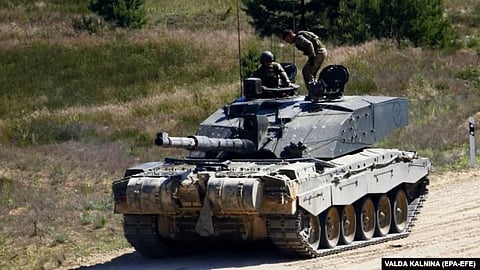
- Home
- न्यूजग्राम
- India
- World
- Politics
- Entertainment
- Culture
- Lifestyle
- Economy
- Sports
- Sp. Coverage
- Misc.
- NewsGram Exclusive
- Jobs / Internships

Britain's Challenger 2 is a battle tank designed to take out opposing tanks. (RFE)
British Prime Minister Rishi Sunak has informed Kyiv that Britain intends to send main battle tanks and artillery support to aid Ukraine's war effort against invading Russian forces.
Sunak discussed Britain's plans during a phone call with Ukrainian President Volodomy Zelenskiy on January 14, according to a spokesperson for the prime minister's office.
"The prime minister outlined the U.K.'s ambition to intensify our support to Ukraine, including through the provision of Challenger 2 tanks and additional artillery systems," said the spokesperson.
Sunak told reporters earlier this week that he had asked Defense Secretary Ben Wallace to go "further and faster with our support for Ukraine, including the provision of tanks." It would mark the first time Britain has supplied heavy armor to Kyiv following Russia's all-out invasion in February.
British Defense Ministry officials have said an official announcement to send up to 12 main battle tanks to Ukraine will be announced at a meeting of Ukrainian donor countries in Germany on January 20.
Reports citing British government sources said four Challenger 2 tanks will be sent immediately, with another eight to follow shortly.
The provision of tanks by countries supporting Ukraine is a contentious topic. Officials in Kyiv have consistently lobbied for modern tanks, but many Western governments were reluctant until recently to fulfill the request out of concerns that doing so could escalate tensions with Moscow.
That thinking appears to have changed with news that multiple NATO countries are now willing to provide modern tanks.
On January 11, NATO member Poland said it was willing to send German-made Leopard tanks to Kyiv "within the framework of an international coalition."
The move by Warsaw, which said it fears it is the "next target" on Russia's invasion list, was intended to put pressure on other NATO members to follow suit.
Finland, which is seeking NATO membership, responded promptly by giving its cautious approval on January 12 to sending Leopard 2 tanks to Kyiv.
Germany, which can veto transfers of exported weapons to third countries, has come under criticism for not sending tanks to Ukraine.
Commitments by other NATO states to provide tanks would make it more difficult for Berlin to stand by its argument that it does not want to be alone in providing Kyiv with tanks.
On January 6, German Vice Chancellor Robert Habeck said Berlin plans to send about 40 Marder infantry fighting vehicles to Ukraine before March as part of a new weapons package.
But just days after the announcement, Ukrainian Foreign Minister Dmytro Kuleba pressed his visiting German counterpart Annalena Baerbock to send tanks, telling Baerbock that the "longer it takes to make the decision, the more people will die."
Vice Chancellor Habeck said after the Polish announcement that Berlin would not prevent Warsaw from exporting Leopard tanks to Ukraine.
Germany said that as of January 13 it had not yet received an official request from Finland or Poland to re-export Leopard tanks.
French officials said last week that they plan to deliver about 40 AMX-10 RC wheeled combat tanks to Ukraine in two months' time.
The French decision, first announced on January 5, was followed by Germany's commitment to send Marder infantry fighting vehicles and a pledge by the United States to send armored Bradley Fighting Vehicles, which can serve as a troop carrier.
Ukraine has received hundreds of modernized versions of the Soviet-era T-72 tank from European and NATO allies like the Czech Republic and Poland since Russia's unprovoked invasion 11 months ago.
But Kyiv has received nothing comparable to the advanced Leopard 2 or Challenger 2, each of which fire highly specific munitions, including 120-millimeter shells.
Britain's Challenger 2 is a battle tank designed to take out opposing tanks, while Germany's Leopard 2 is a main battle tank used extensively by NATO countries. (SJ/RFE)
